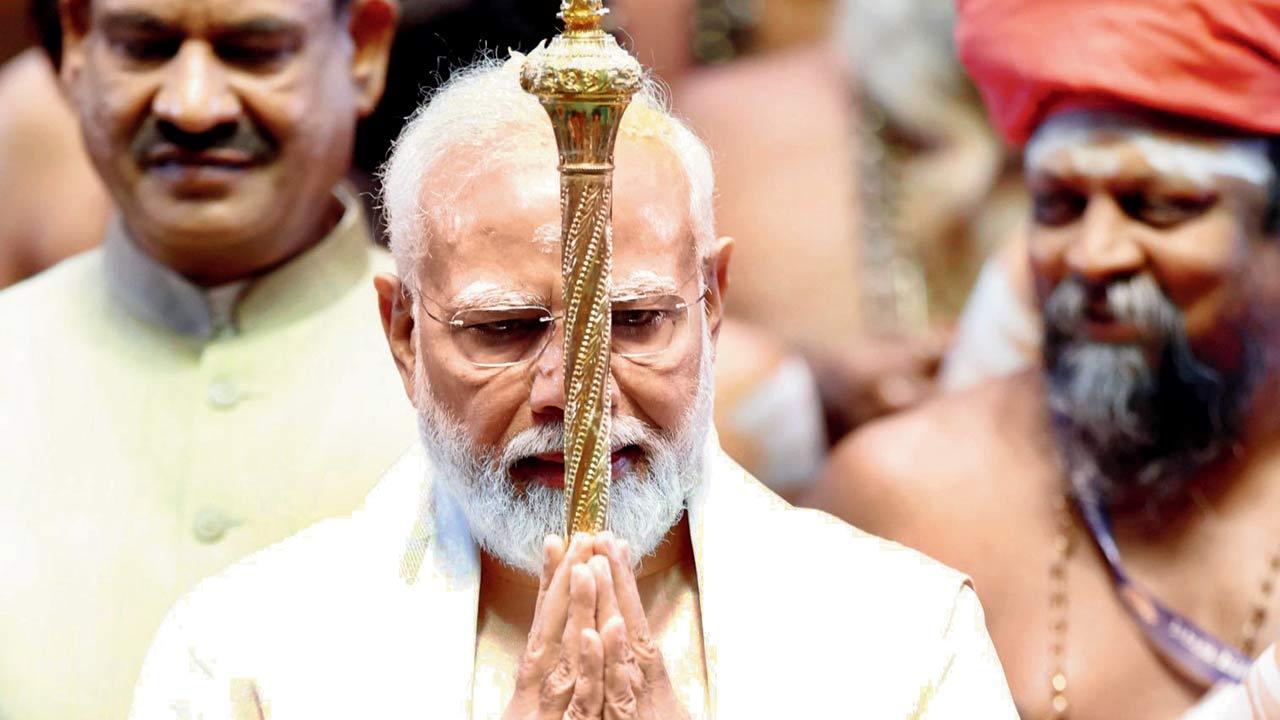The government should spend more on giving Parliamentary proceedings the pomp and majesty they deserve

Prime Minister Narendra Modi at the inauguration of the new Parliament building on May 28. Pic/Twitter
 This is an embarrassing admission to make, but I don’t know what a Sengol is. I know every Indian on the planet is supposed to know about this mysterious, magical object by now, but I haven’t done any research. It dominated news channels and newspaper columns for days, so I know what it looks like, but I’m not sure I understand its history or significance. I know I could have looked, but I simply avoided trying to find out. I have no excuse for my behaviour.
This is an embarrassing admission to make, but I don’t know what a Sengol is. I know every Indian on the planet is supposed to know about this mysterious, magical object by now, but I haven’t done any research. It dominated news channels and newspaper columns for days, so I know what it looks like, but I’m not sure I understand its history or significance. I know I could have looked, but I simply avoided trying to find out. I have no excuse for my behaviour.
ADVERTISEMENT
If I am being honest, I suppose I decided not to Google the object because to do so would take away from the majesty of the spectacle surrounding it. I wanted to just revel in the glitter and glamour of those many holy men and the world’s most respected Prime Minister, without wondering why someone was handing it over to someone else, and why there was so much bowing, praying and chanting involved. All I knew for a fact was that the one thing our government does well is spectacle, for which I am always grateful. So, like any normal Indian, I accepted that this Sengol was important, that Parliament wouldn’t be able to function without it, and that the ceremony was critical for India’s future as a world power. We are nothing without a Sengol, I told myself.
There were all kinds of events occurring at the same time, which sometimes made me feel as if they were planned on purpose to distract us from the Sengol ceremony.
There were those loud and angry wrestlers protesting outside Parliament, for instance, who could have waited for a few days more to raise their voices but chose to be impatient and distract the Delhi police instead. They had been ignored for weeks, so what could the delay of a few days do? Why ruin a perfectly good Sengol ceremony by shouting about ministers and sexual harassment?
Then there were those pesky riots in Manipur. I had no idea if they were real, given that all genuine news channels had decided to focus on the Sengol, so I didn’t have an opinion. Also, if there really were riots and Indians were being attacked, wouldn’t it make sense for the Prime Minister to visit that part of the country and make sure things were okay? Wouldn’t the Home Minister have done this, given it is such an integral part of his job description?
And yet, here they were on television, making sure the Sengol was being transferred safely from one pair of hands to another. That was enough for me to know where my priorities were supposed to lie.
Some parts of the ceremony bothered me, for reasons I couldn’t fathom until I thought about it a few days later. It seemed as if parts of the ritual were inspired by Western traditions, as if the whole thing had been created by an event manager from the United Kingdom or something. I dismissed the thought as preposterous almost instantly, of course, because I knew that the opposite was more likely to be true: that the West must have stolen the idea from us.
A lot of people also complained about the cost of the ceremony, asking why taxpayer funds were being used for what they described as a useless act of drama. I have only pity for these people because of how short-sightedness leaves them unable to grasp the significance of our majestic ceremonies. Yes, it must have been expensive, but since when do we value money more than pride in this New India of ours?
I believe the government should invest more heavily in ceremonies like these because they act as a perfect showcase for how great our country is, and how we aren’t distracted by poverty, malnutrition, climate change, communal riots, corruption, or other minor irritants that tend to bog down most other countries. We should send the world a resounding message that we will continue to focus on important things like the Sengol. We could even repeat the ceremony every six months and replicate it across the country, so every Indian has an opportunity to gaze upon that holy object, no matter the cost.
What we also need are more fact-finding missions to identify and locate similar holy objects that deserve more attention. Who is to say there isn’t a holy stick, or holy cauliflower, or holy parrot, just lying around in some forgotten corner, waiting for a government-sponsored spotlight to fall upon it?
When he isn’t ranting about all things Mumbai, Lindsay Pereira can be almost sweet. He tweets @lindsaypereira
Send your feedback to mailbag@mid-day.com
The views expressed in this column are the individual’s and don’t represent those of the paper
 Subscribe today by clicking the link and stay updated with the latest news!" Click here!
Subscribe today by clicking the link and stay updated with the latest news!" Click here!







